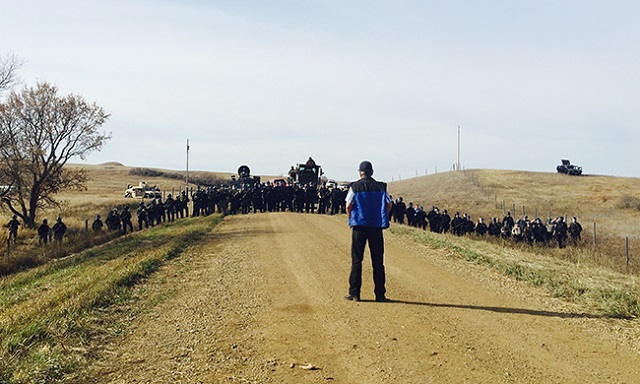
Did you know that Truthout is a nonprofit and independently funded by readers like you? If you value what we do, please support our work with a donation.
Last week, the world watched in horror as a massive militarized police force attacked prayerful Indigenous Water Protectors fighting for the water of 18 million people. Over and over, people were brutalized, pulled out of sweat lodges while in ceremony wearing only their underwear. Medics and journalists were arrested alongside Water Protectors. Cars were searched and impounded, personal possessions were taken by police.
Everyone by now has seen the videos of the assault last Thursday. Here at Standing Rock, the age-old story of government forces raising arms against Native people is being repeated in real time through social media.
But lost in that day, in the horrific stories of degradation, is a small story of victory, of how 40 to 50 Native people stood against more than 250 police on a bridge on County Road 134 in rural North Dakota.
Word-of-mouth announcements went out to the Oceti Sakowin camp that there was going to be a police raid of the front-line camp that had been set up in the way of the pipeline. A raid means people are in imminent danger, and that is widely understood here. Over Labor Day, campers were attacked by dogs and pepper sprayed by Dakota Access security. And since then, we’ve seen increased militarization. It has been apparent that the government, specifically Morton County Sheriff’s office, is the security force protecting the pipeline, so no one doubted that this time the police would be the ones to desecrate bodies and lifeways.
My original plan was to take County Road 134 to photograph the pipeline being forced into the earth.
Instead, I found a blockade of wood logs and hay bales set up in an area where water divided the back country road. No one there was armed with anything other than prayer. It was a strategic juncture because police vehicles couldn’t cross the narrow embankments on their way to the raid. If they were stopped at this bridge from the east, they could only come from the north.
In the morning, police did come, and from both sides. When I arrived, this blockade had already stopped an LRAD — a sonic weapon often called “sound cannon,” which can cause permanent hearing loss — from making it to the camp. Even as police numbers grew, eventually well beyond 200, the Water Protectors held their ground, fearless.
Then the dancing began.
People began dancing to a hand drum, entranced by the power of prayer. A single elder, a veteran, repeatedly walked out and yelled: “Send one unarmed like I am out here to negotiate. Please. We are protecting the water for our children and yours. Send one out here to negotiate. Let’s talk! Please!”
He was met with no negotiation.
But the Water Protectors held the bridge. For hours and hours, police advanced and retreated.
This was an unforgettable moment unfolding. With the dancing going on and the veteran trying to negotiate out front, a young woman stepped up and began moving her body to the beat of the drum. She was power incarnate. Her arms were wide open, her pink fingernail polish glistening. She was crying. Just waiting to be pepper sprayed, she wore a painter’s mask, one which would have done nothing much for protection.
That standoff’s foundation was ceremony and song, the truest essence of religious freedom.
This is what colonial violence looks like: 250 police — some of them snipers, some with guns drawn on the crowd — in a standoff with 40 to 50 unarmed Indigenous people who just want to be allowed to live.
The untold story of this day was that those troops never made it from the east to join the others in raiding the camp, dehumanizing the friends and families of those on that bridge. There were 250 fewer officers able to show up to brutalize people and pervert prayer ceremonies on October 27. History rarely teaches us about when Natives win against the state. And that’s how injustice flourishes: in the shadows.
So let me be clear. On October 27, when a colonial force armed with military weapons faced off on a bridge against veterans armed with only prayer, the Natives won.
Media that fights fascism
Truthout is funded almost entirely by readers — that’s why we can speak truth to power and cut against the mainstream narrative. But independent journalists at Truthout face mounting political repression under Trump.
We rely on your support to survive McCarthyist censorship. Please make a tax-deductible one-time or monthly donation.